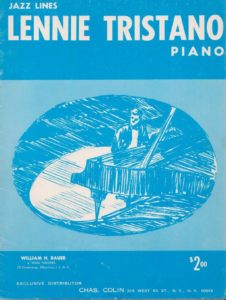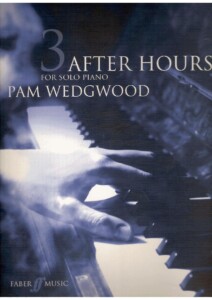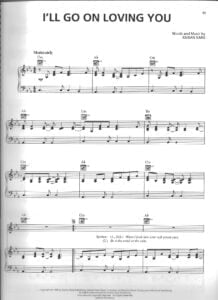Table of Contents
You Don’t Know What Love Is

Lennie Tristano – Who was Lennie Tristano, the Jazz Master (1919-1978)?
Lennie Tristano was born in Illinois, Chicago in 1919 “almost blind in the bosom of a family originally from southern Italy, he began his piano studies with his mother, an opera singer and pianist. At the age of ten he enters a school in Chicago where he studies music theory, alto and tenor saxophones, clarinet and violoncello, and at the same time directs the school orchestra”.
According to the text that accompanies the aforementioned album, at this time Lennie Tristano also played trumpet, guitar and drums. He later starts higher music studies and gets a ‘Bachelor of Music’ in just two years. It is after his studies when he begins to be interested in Jazz and musical improvisation in general.
Download the best Jazz Transcriptions and sheet music from our Library.
His influences, apart from classical music (especially Bach), can be summed up with the following names: Art Tatum, Bud Powell, Earl Hines Lester Young and Charlie Parker. In 1943, he combined his career as a musician with teaching, for which he should also be considered an important ‘Jazz Educator’ (Jazz teacher).
Later he even founded his “New School Of Music” in New York. At that time he coincides with Lee Konitz, alto saxophonist, also originally from Chicago, with a unique style that will play a very important role in his future formations. In 1945, he collaborated with the formation of Earl Swope (trombonist) and Woody Herman (clarinetist, band-leader and singer), moving to New York in 1946.

From his circle of students and colleagues an extraordinary sextet crystallized in 1948: Lee Konitz (alto sax), Warne Marsh (tenor sax), Billy Bauer (guitar), Lennie Tristano (piano), Arnold Fishkin/Harold Granowsky (bass) and Denzil Best (drums).
The group worked closely together for a year, something unusual, until recording Crosscurrent for the Capitol label in March and May 1949 in New York.
What is special about Lennie Tristano’s style is a very linear approach to his improvisations. Until now, melodic improvisation in Jazz was mainly based on playing what the harmonic base pre-established (the vertical part of the music). In other words: melodic instruments played piano or guitar chords in the form of successive notes (arpeggios) to create melodic lines.
Tristano tries to give the melodic line itself more importance, so that it could also exist without harmony. His goal is to avoid the repetition of ideas and to improvise ‘for real’ without the use of ‘licks’ (pre-established and pre-rehearsed melodic fragments). Later, on his album “Lennie Tristano” from 1955, he includes two songs in which he practically does not play any chords, only a great melodic line, a particular thing for a pianist, considering that the strong point of the piano tends to be precisely the chords. .
The last consequence, as paradoxical as it may seem, is the complete annulment of the harmonic instrument in some Cool Jazz formations, such as the Gerry Mulligan Quartet with Chet Baker from 52/53, with the formation: sax, bass trumpet and drums.
Apart from the plain melodic line, he experimented with counterpoint, that is, the simultaneous combination of two or more independent melodic voices. He is in fact considered a pioneer in counterpoint improvisation. Another peculiarity was a total independence of melody and compass.
That is to say: he played asymmetrical phrases that did not correspond to the beats, they went beyond the bar line and the structures of the general form of the musical piece, to such an extent that he had difficulty finding a drummer capable of accompanying him adequately.
The latter obviously also exists in Bebop, for example, but not in such an outlined and intentional way.
When it comes to recording his music, he is probably the first Jazz musician to experiment with the possibility of recording by tracks. This is impressively documented in his ’55 Turkish Mambo track, in which he records three melodic lines on top of each other. Each changing independently of measure during the piece. The result is a delirious combination of voices, counterpoints and polyrhythms.
Despite his special interest in melody also his chords and harmonic links were complex and innovative. To all this we must add another novelty that he introduces in his groups, and that is perhaps the most revolutionary.
At the end of their concerts, Lennie Tristano and his musicians would often play a free piece. The only thing that was remembered before performing was the order of entry of the instruments. That same thing, by the way, he also used to do with his students.
He dedicated his entire life to a single goal: to achieve total mastery of his instrument and the music for it. In this way, he wanted to reach a total state of control and freedom at the same time. In this way he wanted to give way to the essence of Jazz: feeling and emotion, the work that all Jazz musicians do deep down. Lennie Tristano, in a conversation with the critic Barry Ulanov points out: “I can never think and play at the same time […]. It’s emotionally impossible. [Adds Ulanov:] Thought is an anticipation of acting. The studio precedes a recording like this week after week, month after month, year after year.”
His album Crosscurrent (‘Capitol Sessions’) / Intuition was released in parts from 1949 to 1954, as the record company apparently did not dare to release the material at all (probably fearing financial failure, then ignoring its historical importance). Until it was finally published in its entirety in 1972. In 2012, it was included in the ‘Grammy Hall of Fame’ of recordings.
Today more than before the influence of the ‘Tristano School’ continues to have late indirect disciples such as Mark Turner, Kurt Rosenwinkel, Jorge Rossy to name a few.
Best Sheet Music download from our Library.
Browse in the Library:
| Artist or Composer / Score name | Cover | List of Contents |
|---|---|---|
| Aerosmith – I Dont Want To Miss A Thing | ||
| Aerosmith 1973-1979 – Guitar Play Along with MP3 audio Guitar Signature Licks with Tablature |
 |
Aerosmith 1973-1979 Signature Licks |
| Aerosmith Greatest Hits (Guitar) with Tablature |
 |
aerosmith greatist hist guitar |
| Aerosmith Nine Lives Original Songbook Guitar Tabs |
 |
|
| Aesthetics Of Music Musicological Perspectives by Stephen Downes(Book) |
 |
|
| Affections touching across time (Inuyasha OST) Kaoru Wada | ||
| Afi – Love Like Winter | ||
| Afi – Miss Murder | ||
| AFI’s Top 25 Film Scores Songbook |
 |
AFI’s Top 25 Film Scores Songbook |
| Africa – Toto.mscz | ||
| Africa And The Blues (Book) |
 |
|
| Afro Cuban Keyboard Grooves by Manny Patiño and Jorge Moreno |
 |
Afro Cuban Keyboard Grooves by Manny Patiño and Jorge Moreno |
| Afroman – Because I Got High | ||
| After Hours for PIANO DUET by Pam Wedgwood |
 |
After Hours for PIANO DUET by Pam Wedgwood |
| After Hours For Solo Piano. Book 3 (Pam Wedgwood) |
 |
After Hours For Solo Piano. Book 3 (Pam Wedgwood) |
| After Hours for Trumpet and Piano by Pam Wedgwood |
 |
After Hours for Trumpet and Piano by Pam Wedgwood |
| After You’ve Gone Turner Layton And Henry Creamer 1918 Jazz Standard (Vintage sheet music) |
 |
|
| Again, as before, alone (P. I. Tchaikovsky) | ||
| Age of Empires 2 – Main theme | Age of Empires 2 – Main theme | |
| Agnes Obel Chord Left |
 |
|
| Agnes Obel Fuel To Fire |
 |
|
| Agnes Obel Pass Them By |
 |
|
| Agnes Obel – Riverside Piano |
 |
|
| Agnes Obel – September Song |
 |
|
| Agnes Obel – Tokka |
 |
|
| Agnes Obel Falling Catching |
 |
|
| Agnes Obel Falling, Catching |
 |
|
| Agnes Obel Familiar |
 |
|
| Agnes Obel Fuel To Fire |
 |
|
| Agnes Obel It’s Happening Again |
 |
|
| Agnes Obel Just So |
 |
|
| Agnes Obel Mary |
 |
|
| Agnes Obel Riverside |
 |
|
| Agnes Obel September Song |
 |
|
| Agnes Obel Smoke And Mirrors |
 |
|
| Agnes Obel The Curse |
 |
|
| Agnes Obel Tokka |
 |
|
| Agnes Obel Words Are Dead |
 |
|
| Aguas De Março Jazz Piano Score Jobim |
 |
|
| Aha – Take On Me |
 |
|
| Ahead On Our Way Ff Vii (Musescore File).mscz | ||
| Ahmad Jamal Poinciana Full score (Song of the Tree) | Ahmad Jamal Poinciana Full score (Song of the Tree) | |
| Ahmad Jamal The Ahmad Jamal Collection (Artist Transcriptions) |
  |
Ahmad Jamal The Ahmad Jamal Collection Artist Piano Transcriptions contents Ahmad’s Blues, But Not For Me, The Canteen, For My Daughter, My Flower, New Rhumba, Night Mist Blues, Poinciana (Song Of The Tree), Sumayah, The Surrey With The Fringe On Top |
| Ahmad Jamal Wave from the album The Awakening |
 |
|
| Ai Mei – Rainie Yang | ||
| Aimee Mann – Wise Up | ||
| Ain’t Misbehavin’ Fats Waller As Played By Joe Pass (Musescore File).mscz | ||
| Ainsi soit je (Mylène Farmer) | ||
| Air on the G string, from BWV 1068 (10 string, Yepes tuning).mscz | ||
| Air Supply Greatest Hits |
 |
AIR SUPPLY GREATEST |
| Airegin by Soony Rollins – Jazz Play Along with sheet music |
 |
Airegin |
| Akira Ifukube – Sonata for Violin and Piano I – Allegro |
 |
|
| Akira Ifukube End Titles Godzilla Vs Destoroyah |
 |
|
| Akira Ifukube Mesa March Godzilla |
 |
|
| Akira Yamaoka Silent Hill 2 Promise (Reprise) |
 |
|
| Akira Yamaoka, Silent Hill Room Of Angel (Piano) | Akira Yamaoka, Silent Hill Room Of Angel (Piano) | |
| Aknin, Laurent Le Choix Du Coeur Easy Piano Solo (du film The Student and Mister Henri (L’Étudiante et Monsieur Henri) | Aknin-Laurent-Le-Choix-Du-Coeur-Easy-Piano-Solo | |
| Al Di Meola – Guitar Technique SongBook with Tablature |
 |
Al Di Meola – Guitar technique SongBook |
| Al Di Meola A Guide To Guitar Chords Scales And Arpeggios Master Classes With Bob Aslanian |
 |
Al Di Meola A Guide To Guitar Chords Scales And Arpeggios Master Classes With Bob Aslanian |
| Al Di Meola Collection |
 |
al di meola collection songbook |
| Al Di Meola Enigma Of Desire (Guitar) |
 |
|
| Al Di Meola Guitar School Elegant Gypsy Songbook with Tablature |
 |
Al Di Meola Guitar School Elegant Gypsy Songbook |
| Al Di Meola Guitar Tabs Songbook Electric Rendezvous |
 |
Al Di Meola Guitar Tabs Songbook Electric Rendezvous |
| Al Di Meola Solace (Guitar) | Al Di Meola Solace (Guitar) | |
| Al Di Meola Solos (Guitar) with Tablature |
 |
al di meola solos |
| Al Di Meola Super Guitarist Guitar Tabs Songbook |
 |
Al Di Meola Super Guitarist Guitar Tabs Songbook |
| Al Di Meola When Youre Gone | Al Di Meola When Youre Gone | |
| Al Green – Let´s Stay Together Melody And Guitar Chords |
 |
|
| Al Green Let’s Stay Together |
 |
|
| Al Jarreau – Breakin’ Away |
 |
|
| Al Jarreau Spain (I can recall) Piano Vocal Guitar Chords |
 |
|
| Al Jarreau The Best Of Al Jarreau Piano Vocal Guitar chords |
 |
Al Jarreau The Best Of Book |
| Al Stewart – Time Passages |
 |
|
| Al Stewart – Year Of The Cat |
 |
|
| Al Stewart Greatest Songs Of Book |
 |
AL STEWART SONGBOOK |
| Aladdin – A Whole New World – Alan Menken | Aladdin – A Whole New World – Alan Menken | |
| Aladdin – Arabian Nights (Musescore File).mscz | ||
| Aladdin – Broadway Musical Songbook – Alan Menken |
 |
Aladdin – Broadway Musical Songbook – Alan Menken |
| Alain Barriere – Les Guinguettes |
 |
|
| Alain Barrière – Emporte Moi (Y Volveré) |
 |
|
| Alain Barriere – Tu T’en Vas |
 |
|
| Alain Chamfort Songbook Book |
 |
ALAIN CHAMFORT SONGBOOK |
| Alain Souchon Au Ras Des Paquerettes Piano Vocal Guitar TAB |
 |
Alain Souchon Au Ras Des Paquerettes Piano Vocal Guitar TAB |
| Alain Souchon Ecoutez d’où Ma Peine Vient Piano Vocal Guitar chords |
 |
Alain Souchon Ecoutez d’où Ma Peine Vient Piano Vocal Guitar chords |
| Alain Souchon les plus grands succès de (partitions, sheet music) Piano Vocal |
 |
Alain Souchon les plus grands succès de (partitions, sheet music) Piano Vocal |
| Alan Belkin – Una Guía Práctica de Composición Musical (Spanish) | Book Theory | |
| Alan Jackson – Between the Devil and Me |
 |
|
| Alan Jackson – Buicks to the Moon |
 |
|
| Alan Jackson – I’ll Go On Loving You |
 |
|
| Alan Jackson – It’s Five Oclock Somewhere |
 |
|
| Alan Jackson – Little Bitty |
 |
|
| Alan Jackson – Once In A Lifetime Love |
 |
|
| Alan Jackson – Remember When |
 |
|
| Alan Jackson – That’d Be Alright |
 |
|
| Alan Jackson – There Goes |
 |
|
| Alan Jackson – Where I Come From |
 |
|
| Alan Jackson Remember When Piano Solo |
 |
|
| Alan Lomax – The Penguin Book Of American Folk Songs (GUITAR) |
 |
Alan Lomax – The Penguin Book Of American Folk Songs GUITAR) |
| Alan Menken – A Christmas Carol A Place Called Home |
 |
|
| Alan Menken – Beauty and the Beast (easy piano) Complete score arr. piano & guitar chords |
 |
Alan Menken – Beauty and the Beast (easy piano) |
| Alan Menken – Little Shop Of Horrors |
 |
Alan Menken – Little Shop Of Horrors |
| Alan Menken – Songbook |
 |
Alan Menken songbook sheet music |
| Alan Menken – Tangled (Disney) Rapunzel songbook |
 |
Tangled |
| Alan Menken A Christmas Carol (The Musical) |
 |
|
| Alan Menken Aladdin (songbook) |
 |
Alan Menken Aladdin |
| Alan Menken I see the light (Tangled-Disney) | Alan Menken I see the light (Tangled-Disney) | |
| Alan Menken My Christmas Tree from Home Alone 2 Lost In New York |
 |
|
| Alan Menken The Hunchback Of Notre Dame (Disney) |
 |
Alan Menken The Hunchback Of Notre Dame (Disney) |
| Alan Menken The Little Mermaid Piano Vocal Score (The Musical) | Alan Menken The Little Mermaid Piano Vocal Score (The Musical) | |
| Alan Parsons – Eye in the Sky |
 |
|
| Alan Parsons Project – Don’t Answer Me |
 |
|
| Alan Parsons Project – Eye In The Sky |
 |
|
| Alan Parsons Project – Time |
 |
|
| Alan Parsons Project – Eve (Piano, Vocal, Guitar) Songbook |
 |
Alan Parsons Project – Eve (Piano, Vocal, Guitar) Songbook |
| Alan Parsons Project – Eye In the Sky (Piano, Vocal, Guitar Songbook) |
 |
Alan Parsons Project – Eye In the Sky (Piano, Vocal, Guitar Songbook) |
| Alan Parsons Project – I Robot (Piano, Vocal, Guitar) Songbook |
 |
Alan Parsons Project – I Robot (Piano, Vocal, Guitar) Songbook |
| Alan Parsons Project – The Essential |
 |
Alan Parsons Project |
| Alan Parsons Project Gaudí Piano Vocal Guitar chords |
 |
Alan Parsons Project Gaudí Piano Vocal Guitar chords |
| Alan Silvestri – Avengers Infinity War Medley – Piano Solo | Alan Silvestri – Avengers Infinity War Medley – Piano Solo | |
| Alan Silvestri – Contact Main Theme |
Lennie Tristano discography
Intuition (1946–52; Box 4 CD + Booklet 40 S.(en), compil. 2003 Proper/mcps)
Complete Recordings of Charlie Parker with Lennie Tristano (1947–51, ed. 2006)
Live at Birdland 1949 (Jazz Records 1979, 1990)
Live in New York (1949; with Lee Konitz, Warne Marsh, Billy Bauer u. a., compil. 2004 by Jazz Door)
Crosscurrents Capitol 1949 (als Album veröffentlicht erst 1972)
Descent into the Maelstrom, Inner City 1952
Lennie Tristano (Atlantic, 1956)
The New Tristano (Atlantic, 1961)
Concert in Copenhagen (aufgenommen 1965, Jazz Records 1997)
The Duo Sessions (Dot Time, ed. 2020)
Personal Recordings 1946-1970 (Mosaic/Dot Time, ed. 2021)Collection
The Complete Atlantic Recordings of Lennie Tristano, Lee Konitz & Warne Marsh (1955-58) – (Mosaic – 1997) – 10 LPs oder 6 CDs – Lennie Tristano p mit Lee Konitz, Gene Ramey, Art Taylor, Peter Ind, Jeff Morton dm –
Lee Konitz as mit Sal Mosca, Peter Ind, Dick Scott dm, Billy Bauer, Arnold Fishkind b, Jimmy Rowles, Leroy Vinnegar, Shelly Manne, Don Ferrara – Lee Konitz & Warne Marsh ts mit Sal Mosca, Billy Bauer, Oscar Pettiford, Kenny Clarke, Ronnie Ball p – Warne Marsh mit Ronnie Ball, Paul Chambers, Philly Joe Jones, Paul Motian